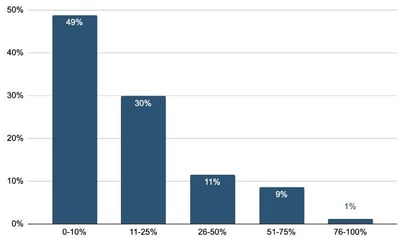Webinar recap: "The future of direct mail (with special guest Josh Alcorn)"

Did you miss our latest webinar on "The future of direct mail (with special guest Josh Alcorn)"?
We've gathered the biggest takeaways for you!
Direct mail in 2023
We surveyed nonprofit fundraisers and asked:
"On average, what percentage of your nonprofit's income comes from direct mail campaigns?"

Direct mail...
1. Proves its worth
56% of donors think print marketing is the most trustworthy out of all marketing channels. Direct mail campaigns have an ROI of 112%. And 67% of people feel mail provides a more personal connection vs. the Internet.
2. Is memorable
It requires 21% less cognitive effort to process than email because our brains have an easier time remembering tactile objects (no ads, open tabs, etc.). It also takes up physical space – a piece of mail, on average, has a life of 17 days before being recycled.
3. Is popular across age groups
The majority of Americans believe mail brings a sense of discovery to their lives. These days, people feel excited to receive mail daily (Boomers: 70%, Gen X: 70, Millennials: 79%, Gen Z: 72%).
Note: The pandemic changed our relationship with mail. 46% of consumers are more interested in direct mail now than before the pandemic!
4. Makes a dynamic duo when paired with a strong website
44% of people said they had visited a website after receiving postcards; 34% searched online. Mail proves trustworthiness to recipients but your digital presence proves your validity.
5. Has passed its peak
Mail volume has plummeted since 2006. Increasingly, the USPS is more of a package delivery service rather than letter delivery.
6. Makes a dynamic duo when paired with a strong website
44% of people said they had visited a website after receiving postcards; 34% searched online. Mail proves trustworthiness to recipients, but your digital presence proves your validity.
7. A note about checks: Giving by check is in serious decline for all age groups
45% of American adults did not write a single check in 2022, according to Yahoo! News. Fewer than 15% of Americans say they write “several checks a month.” And the Federal Reserve of Philadelphia predicts that paper checks will be obsolete by 2026.
Five tips for a successful direct mail fundraising campaign
1. Use channels together.
Direct mail can be great for detailed storytelling and reintroducing lapsed donors. Digital is ideal for timely communication & instant donations. Instead of an either/or approach, send an email a few days after the letter is expected to arrive, and reference the letter in your email – this will add heft!
“I sent you a letter in the mail, but I’m also emailing because this is so important…”
2. Include an easy way for your donors to respond.
Provide a QR code and link it to your donation page (but make sure your pages are mobile-friendly). For previous donors, consider a postage-paid reply envelope. As donors move away from checks, provide ways to give online via credit card. Also, offer clear instructions to ensure donors know alternative ways to give.
3. Increase the highest suggested amount on your reply card.
One experiment using 60,000 fundraising appeal letters from a hospital offered the three most common gift amounts on the standard response card ($10 / $50 / $100 / $___ ).
But an alternative version added higher amounts ($10 / $50 / $100 / $250 / $500 / $___ ).
The second version raised twice as much money per letter. Of note, another version worked just as well – it had suggested amounts of only: $10 / $500 / $___!
Note: This is not the same as increasing all of the options. Increasing the smallest option has a downside – it makes a smaller gift seem unacceptable and reduces the share of people who give at all.
4. Ask donors to keep your message.
Direct mail is held for much longer than digital outreach. Use this to your advantage by asking donors to hold on to your letter/message until they’re ready to give. If you have a guide to different areas of giving to your org, add (in big letters): “Please keep this message for future reference.”
5. Create a permanent “Giving Guide.”
People are more generous when they anchor on assets, and these gifts are more tax-friendly for donors. Send a permanent “Giving Guide” in the fall (Sept. to early Nov.) to existing donors who’ve given $100 or more. Ask them to hold onto the guide for future reference.
Watch the full webinar recording to learn how other nonprofit fundraisers are currently feeling about this standard fundraising practice and for incredible insights from our very special guest, Josh Alcorn, Co-Producer of the Nonprofit Storytelling Conference.
Interested in what we do at FreeWill? Schedule a 1-on-1 conversation with our team to learn more about how we've raised $8.3 billion for our nonprofit partners.


.webp)

